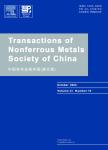Effects of various sintering methods on microstructure and mechanical properties of CP-Ti powder consolidations
烧结方法对CP-Ti粉末烧结块显微组织和力学性能的影响(英文)作者机构:Department of Advanced Materials Engineering Kumoh National Institute of Technology Gumi Gyeongbuk 730-701 Korea Advanced Technology Team Pohang Institute of Metal Industry Advancement Pohang Gyeongbuk 790-834 Korea Titanium Department Korea Institute of Materials Science (KIMS) Changwon Gyeongnam 642-831 Korea
出 版 物:《Transactions of Nonferrous Metals Society of China》 (中国有色金属学报(英文版))
年 卷 期:2014年第24卷第S1期
页 面:59-67页
核心收录:
学科分类:08[工学] 080502[工学-材料学] 0805[工学-材料科学与工程(可授工学、理学学位)]
基 金:Project(K0004130) supported by the Fundamental R&D Program for Core Technology of Materials funded by the Ministry of Knowledge Economy Korea
主 题:CP-Ti powders sintering method spark plasma sintering hot pressing electrical resistance sintering
摘 要:Effects of various sintering methods such as spark plasma sintering(SPS), hot pressing(HP) and electric resistance sintering(ERS) on the microstructure and mechanical properties of commercial pure titanium(CP-Ti) powder consolidations with particle size of 147 μm, 74 μm and 43 μm were studied. The smaller particle powders are densified to proceed at a higher rate. Dense titanium with relative density up to 99% is found to take place at 850 °C under 30 MPa of SPS and HP condition. However, in case of ERS, CP-Ti powders were densified almost at 950 °C under 30 MPa. The microstructure of sintered titanium is composed of equiaxed grains at 850-950 °C. The yield strength of sintered body composed of 43 μm powder is 858 MPa by using SPS at 850 °C under 30 MPa. When there is a higher content of small particle, the higher yield strength value is obtained both by using SPS and HP. However, when ERS is introduced, the highest yield strength is 441 MPa at 950 °C under 30 MPa, which shows much lower values than those by SPS and HP methods. ERS method takes much less sintering time compared with SPS and HP. Nevertheless, higher sintering temperature results in lower strength and elongation because of brittle fracture.



